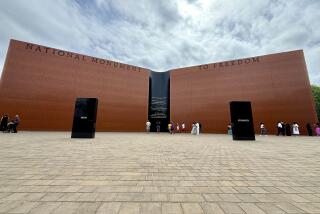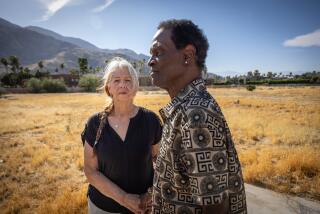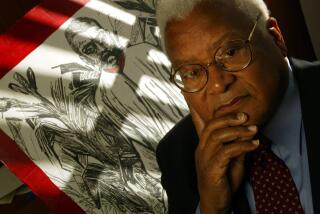Scenes of Civil Rights Struggles Become Popular Tourism Stops : Black heritage: Sites linked to Dr. Martin Luther King Jr. draw the most visitors. Other locations recall the violent episodes.
MEMPHIS, Tenn. â The young black lawyer traveled from San Francisco. The white woman came from a small town in Iowa, bringing along her two teen-age daughters.
They, like 130,000 others in the last year, were drawn to the balcony of the Lorraine Motel--the spot, frozen in a grainy newsphoto image, where Dr. Martin Luther King Jr. died.
âI want to teach my children so that the injustice wonât continue,â Kathy Gerber of Algona, Iowa, said quietly.
âThe sacrifices people made. . . . â whispered the lawyer, Chris Wilkinson. He shook his head.
The Lorraine no longer is a motel. Gutted and reopened in 1991 as the National Civil Rights Museum, it is just one stop along an increasingly well-traveled Southern circuit of new memorials to the bloody and bloodless triumphs of the civil rights movement.
Tour companies and state tourism officials, accustomed to steering visitors to more comfortable, often musty historic sites, are starting to focus on the painful recent past.
A state-published pamphlet, âAlabamaâs Black Heritage,â for example, features many places where civil rights activists bled or died in the 1960s.
âIâve had people call here and say, âWhy would you produce a booklet that would highlight such a negative?â â said Frances Smiley, black heritage coordinator for the state tourism division.
She makes no apology: âPeople want to walk in the footsteps; they want to sit in the pews. . . . We promote it, yes. It changed the course of American history.â
Tours stop at the Selma, Ala., bridge where voting rights marchers were beaten and at the Birmingham, Ala., church where four black Sunday school pupils died in a bombing.
Kingâs birthplace and his white marble tomb, just a block apart in Atlanta, are the most visited sites, with 3.2 million visitors last year. They are centerpieces of the MLK National Historic Site, established in 1980.
Other major destinations, besides the Lorraineâs National Civil Rights Museum, include:
* The Birmingham Civil Rights Institute, which opened in mid-November and already has drawn at least 35,000 visitors. The instituteâs $12-million museum, archive and conference center anchor a downtown historic district in the city once called âBombinghamâ for its racial violence.
* The Civil Rights Memorial in Montgomery, Ala., an evocative granite monument combining a fountain with a millstone-like table inscribed with the names of slain activists. It was dedicated in 1989 outside the Southern Poverty Law Center, which says the memorial had 200,000 visitors last year.
* The National Voting Rights Museum in Selma, which opened in March, 1992, and has attracted about 6,000 visitors. A bill sponsored by Rep. John Lewis (D-Ga.) would designate as a National Historic Trail the Selma-to-Montgomery route marchers followed in 1965. It will show âwhat people had to overcome to make the democratic process real for all people,â Lewis said.
Learning from history is the goal of most visitors, those in the industry say.
âThe interest is threefold over what it was last year,â Roger Pennyman of Atlanta Specialty Tours said.
His agency offers a three-day, two-night package for between $115 and $320 per person. Highlights include visits to King sites in Atlanta and several places in Alabama.
Most clients, Pennyman said, are from outside the South, including Canadian and French tourists; about 60% are black. He dismisses arguments that the tours commercialize any site where people died.
âIf you try to make it into a shrine or something, then youâre defeating the purpose of why people were in the movement in the first place. They were in it to get the word out to other people,â said Pennyman, adding that education is his own goal. âWeâre not in this to get rich.â
Still, some critics say the memory of martyrs like King is diminished if he is transformed from hero in life and icon in death to tourist attraction.
âI view this as a sacred site. . . . Itâs not right,â said Jacqueline Smith, a former Lorraine motel tenant who wages a daily protest outside the new museum. Her sign reads: âBoycott Civil Wrong Museum: Tourist Trap.â
She argues that the site should be used to carry on Kingâs work for the poor.
Museum curator Barbara Andrews responds: âWe canât house, clothe and feed people--but we can educate them.â
The education for Wilkinson, the 26-year-old lawyer, was âa sense of loss, a sense of tragedy, but also . . . a sense of whatâs changed.â
For Gerber, visiting the Lorraine was partly atonement for not joining other college students in the â60s who traveled South for civil rights work. âI always felt bad that I didnât come here,â she said.
She and daughters Claire, 16, and Anne, 14, pored over the exhibits inside, including a bus representing the Montgomery city transit vehicle in which Rosa Parks made history in 1955 by refusing to surrender her seat.
âMove to the back,â a taped voice said as tourists climbed aboard and awkwardly passed through. Black parents explained quietly to their young children what the phrase meant back then.
âThis is a very hard, tough story,â said Odessa Woolfolk, board president of the Birmingham Civil Rights Institute. There, visitors halt silently at the bars of Kingâs jail cell door, and at newsreel images of bandaged Freedom Riders telling how their bus was attacked.
âWe were afraid anger would spill out as they went through and encountered people of different races,â Woolfolk said. But she and officials at the Lorraine and other sites said that has not happened.
âItâs a pain--and a puzzlement, maybe,â she said, summarizing a common view: âWeâre really all the better for what has happened. One need not be bitter.â
In the instituteâs lobby, a sign-in book invites visitors who participated in civil rights work to say how; they will be contacted later for an oral history project. Among the entries:
âSeven days, six nights jailed, 1963.â
âRode the bus.â
âPrayed!â
The institute faces Kelly Ingram Park, made infamous by scenes of firehoses trained on demonstrators in 1963. Redesigned, the park now has sculpted images of a young black man and woman turning away from the brutal cascade.
The adjacent Sixteenth Street Baptist Church always had a trickle of visitors, but thousands have come since the institute opened, said the pastor, Christopher M. Hamlin. The 1963 bombing there outraged the world and galvanized support for civil rights initiatives.
Some visitors weep for the four dead girls, but Hamlin said the site must not be a cloister. Video camera use, for example, is not forbidden.
âI know there are a lot of people in Detroit whoâll never make a trip, a pilgrimage, to Birmingham,â Hamlin explained. âAnd if there are people visiting who are able to take a picture, then thatâll let them see what happened here.â
A visitor from Baltimore, Kewanee Malone Smith, brought her 15-year-old son to the church after a tour of the institute; he will write a school report when he gets home.
âI was glad to see the church doors open,â said Smith, a black Birmingham native who remembers the explosion, the firehoses, the police dogs. Surveying the new historic district, her lip trembled.
âWhen I see this,â she said, âit just brings tears to my eyes.â
More to Read
Sign up for The Wild
Weâll help you find the best places to hike, bike and run, as well as the perfect silent spots for meditation and yoga.
You may occasionally receive promotional content from the Los Angeles Times.






